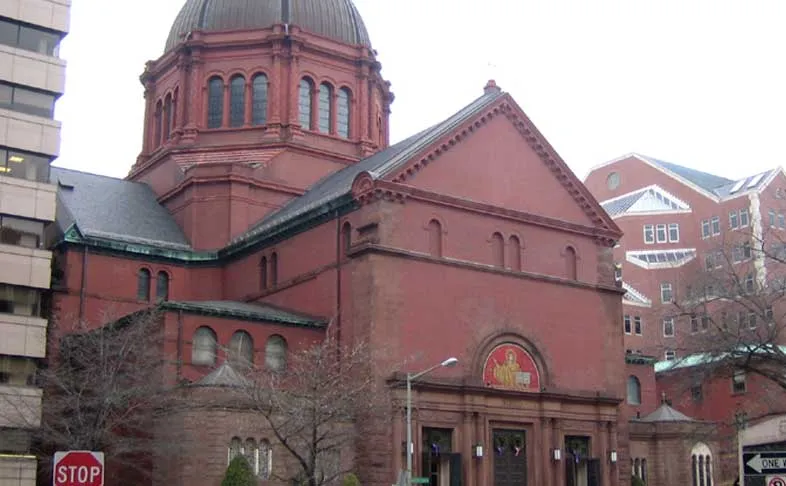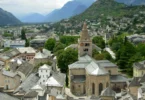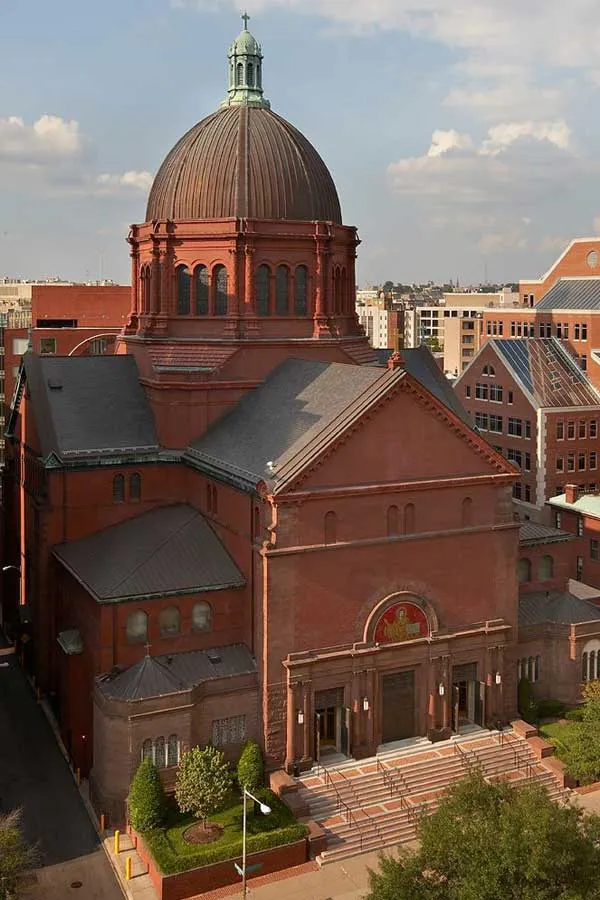
Introduction
The Cathedral of Saint Matthew The Apostle, Washington, D.C., most commonly known as St. Matthew’s Cathedral, is the seat of the Archbishop of the Roman Catholic Archdiocese of Washington. As St. Matthew’s Cathedral and Rectory, it was listed on the National Register of Historic Places in 1974.
The cathedral is in downtown Washington at 1725 Rhode Island Avenue NW between Connecticut Avenue and 17th Street. The closest Metrorail station is Farragut North, on the Red Line. It is seven blocks north and two blocks west of the White House.
The Cathedral church and parish is named for Saint Matthew the Apostle, the patron saint of civil servants, recognizing all those who serve in the municipal, state, and national governments and the many international organizations located in the metropolitan area. The church is the seat or cathedra of the Archbishop of Washington. As the Mother Church of the archdiocese, it plays a major role in the Catholic life of the nation’s capital.
Twice our Cathedral Parish has been honored with a visit here from the Chief Shepherd of the Church Universal. The first was in 1979 when Saint John Paul II celebrated Mass, and the second in 2015, our 175th Parish Anniversary year, when Pope Francis came to pray with our nation’s bishops. President John F. Kennedy’s funeral Mass was celebrated in the Cathedral on November 25, 1963.
Requiems have been held here for several heads of state. Annually, on the Sunday before the first Monday in October when the Supreme Court of the United States begins its regular term, a special Mass is celebrated praying for the Holy Spirit to guide all those who are members of the legal profession. Known as the “Red Mass” in reference to the vestment color, the Supreme Court justices, members of Congress, the President’s Cabinet, diplomatic corps, local municipal, state and national government leaders, and sometimes the President of the United States join the celebration.
History of Cathedral of Saint Matthew The Apostle

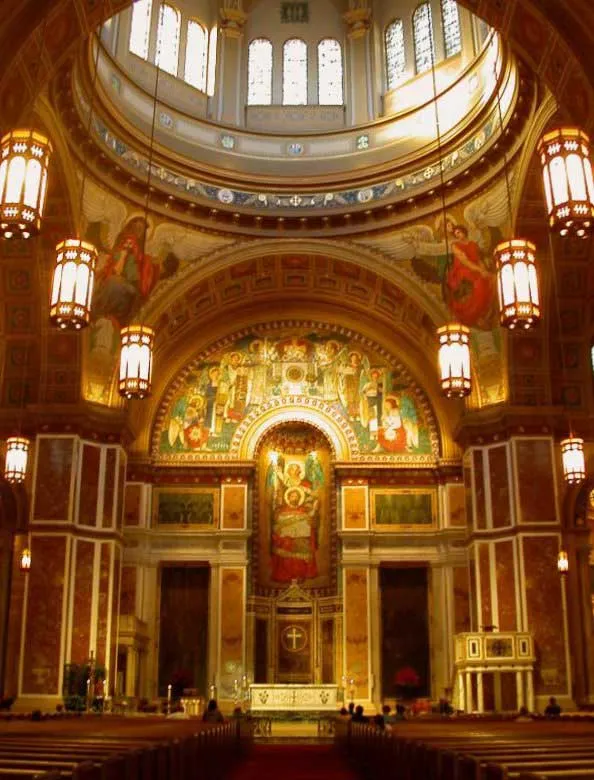
St. Matthew’s is dedicated to the Apostle Matthew, who among other things is patron saint of civil servants, having himself been a tax collector. It was established in 1840 by pastor Father William Matthews and parochial vicar Father John Philip Donelan. The church was dedicated on November 1, 1840, though the structure had not yet been entirely completed.
Originally located at 15th and H Streets, construction of the current church began in 1893, with the first Mass being celebrated June 2, 1895. Construction continued until 1913 when the church was dedicated. In 1939, it became the cathedral for the newly established Archdiocese of Washington.
The parish of St. Matthew the Apostle was the fourth established in the District of Columbia, on the northeast corner of 15th and H Streets, NW. It was dedicated on November 1, 1840 and served its parishioners through the 1890s.
In 1892, its then-pastor, Monsignor Thomas Sim Lee, purchased the land on which the current church structure is located on Rhode Island Avenue, NW. He commissioned the architect Christopher Grant LaFarge to work on the design of the new church structure. LaFarge had worked on the plans for the Cathedral of St. John the Divine in New York City and the Cathedral of St. James in Seattle.
His church design was accepted in 1893. The cornerstone was laid and blessed in 1893 and the first Mass celebrated in 1895. Construction continued in various stages with the dome put in place in 1913. After Monsignor Lee’s death, the new pastor, Fr. Edward Buckey, completed the interior.
In 1939, St. Matthew’s was designated a Cathedral when the combined Archdiocese of Baltimore and Washington was created under the leadership of Archbishop Michael Curley of Baltimore. Upon Curley’s death in 1947, Washington was separated from Baltimore and the Archdiocese of Washington was established. St. Matthew’s became the Mother Church of the new archdiocese. In 1974, the Cathedral of St. Matthew the Apostle was placed on the National Register of Historic Places.
On November 25,1963, the funeral of the 35th President of the United States, John F. Kennedy was celebrated in the Cathedral and is memorialized by a marble plaque imposed in the floor immediately before the gates of the sanctuary commemorating the place where his casket was placed for the funeral Mass and rites. Funeral services have also been held at the Cathedral for other notables, such as the Chief Justice of the United States William Rehnquist and Associate Justice William J. Brennan.
Mother Teresa visited St. Matthew’s in 1974. A statue of Mother Teresa and a homeless man, sculpted by the Russian artist, Leonid Bodnia, was installed in Our Lady’s Chapel to commemorate her visit.. On October 6, 1979, Pope John Paul II celebrated Mass at the Cathedral for the clergy of the Archdiocese of Washington and Baltimore and the Dioceses of Arlington, Richmond and Wheeling-Charleston. A bust in commemoration of his visit, sculpted by Gordon Kray, is displayed in the St. Anthony Chapel.
In 1999, the Cathedral underwent a major restoration with major repairs to the exterior dome, along with extensive work on the interior to refurbish the mosaics and other artwork in the interior, to upgrade the lighting and sound systems and other functional parts of the interior. The extensive effort was completed in 2003 with a grand celebration on September 21st, the feast of St. Matthew. A plaque commemorating the Stewards who gave generously to the restoration is located at the entrance to the Baptistry.
Pope Francis led Midday Prayer with the United States’ bishops at the Cathedral on September 23, 2015 during his apostolic visit to the United States. Pope Francis’ visit to St. Matthew’s Cathedral in 2015 – our 175th Parish Anniversary Year – is memorialized in a commemorative plaque on the wall behind the statue of Mother Teresa and a homeless man.
Historic Events

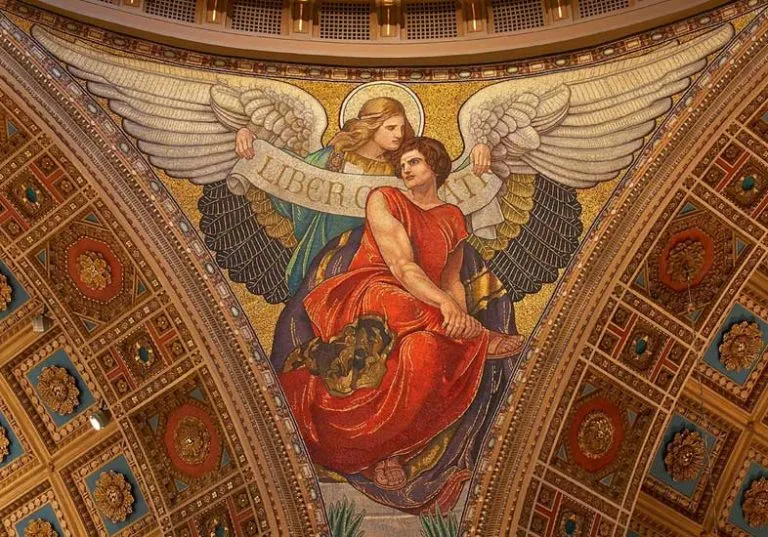
The first notable funeral Mass offered at St. Matthew’s was for Manuel L. Quezon, the president of the Philippines, who died August 1, 1944, and was interred at Arlington National Cemetery until the end of World War II. In 1957, a Solemn Requiem Mass was offered at the cathedral for the funeral of Senator Joseph McCarthy; the liturgy was attended by 70 senators and hundreds of clergymen and it was filled to capacity.
The Cathedral drew worldwide attention following the assassination of United States President John F. Kennedy on Friday, November 22, 1963, in Dallas, Texas. Richard, Cardinal Cushing, Archbishop of Boston and a Kennedy family friend, offered a recited (not sung) Pontifical Requiem Low Mass during the state funeral on Monday, November 25, 1963, which was followed by the procession to Arlington National Cemetery in Virginia for the burial.
Other notable events at the cathedral include a Mass celebrated by Pope John Paul II during his 1979 visit to Washington, D.C., and the 1997 funeral of U.S. Supreme Court Associate Justice William J. Brennan, Jr.
The cathedral was the site of a Lutheran funeral service for Chief Justice William Rehnquist on September 7, 2005.
St. Matthew’s is the location for one of the most famous Red Masses in the world. Each year on the day before the term of the Supreme Court of the United States begins, Mass is celebrated to request guidance from the Holy Spirit for the legal profession. Owing to the cathedral’s location in the nation’s capital, the Justices of the Supreme Court, members of Congress and the Cabinet, and many other dignitaries (including, at times, the President of the United States) attend the Mass. Dwight Eisenhower became the first to attend as president in 1954; Harry Truman attended nine years earlier, but as vice president.
In 2020. St. Matthew’s hosted its first Archdiocesan Easter Mass since the larger Basilica of the National Shrine of the Immaculate Conception was dedicated 1959. The mass, televised on EWTN and on livestream, was celebrated by Archbishop Wilton Gregory in front of an empty cathedral because of the threat of COVID-19.
Prior to the inauguration of Joe Biden as the 46th President of the United States he, along with Senate Majority Leader Mitch McConnell, Senate Minority Leader Chuck Schumer, Speaker of the United States House of Representatives Nancy Pelosi and House Minority Leader Kevin McCarthy attended mass at the church.
Architecture of Cathedral of St. Matthew The Apostle

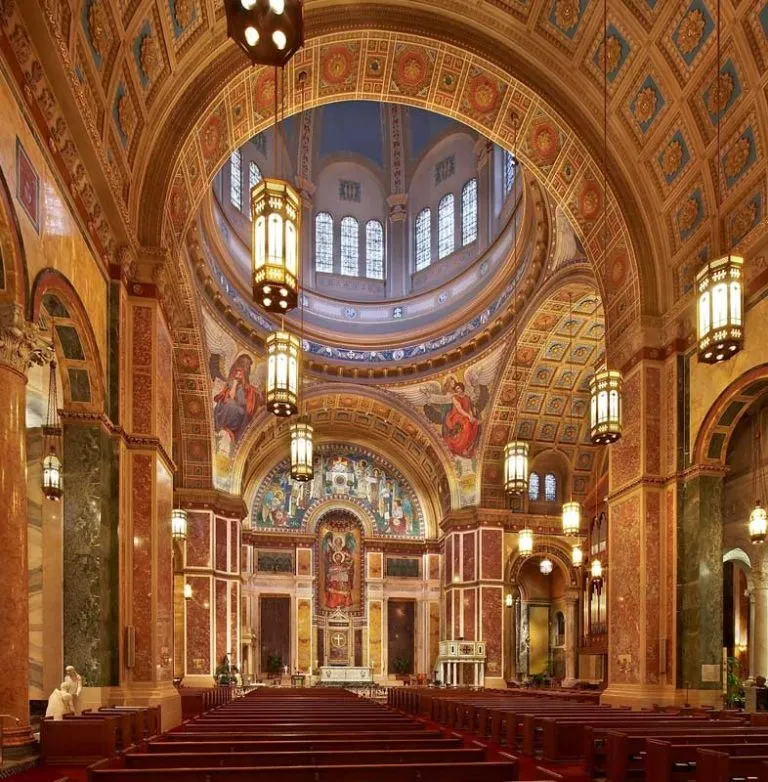
- Architectural styles: Renaissance Revival Architecture, Romanesque Revival Architecture.
- Architecture firm: Heins & LaFarge
- Opened: 1913
The structure is constructed of red brick with sandstone and terra cotta trim in the Romanesque Revival style with Byzantine elements. Designed by architect C. Grant La Farge, it is in the shape of a Latin cross measuring 155 ft × 136 ft (47 m × 41 m) and seats about 1,200 persons. The interior is richly decorated in marble and semiprecious stones, notably a 35 ft (11 m) mosaic of Matthew behind the main altar by Edwin Blashfield.
The cathedral is capped by an octagonal dome that extends 190 ft (58 m) above the nave and is capped by a cupola and crucifix that brings the total height to 200 ft (61 m). Both structural and decorative elements underwent extensive restoration between 2000 and September 21, 2003, the feast day of St. Matthew.
Matthew : Saint and Patron
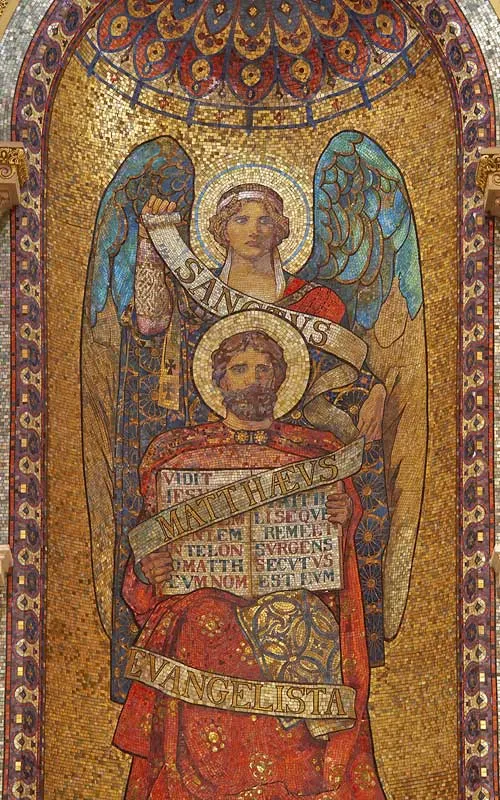
In New Testament writings, Matthew is known by the name “Levi” and also as the “son of Alphaeus.” Levi was probably his original name. He may have been given the name Matthew (translated from the Hebrew to mean “gift of Yahweh”) when he became a follower of Jesus.
His position as a collector of taxes for the Romans classified him as a publican. The position was not popular with the general public, even less so with the Jewish class of people known as the Pharisees. In fact, Jews who held this office were not permitted to marry a Jewish woman nor worship in the synagogue and were generally shunned by civil society.
Matthew’s life is changed when Jesus comes upon him carrying out his tax collection duties in the custom house. Jesus calls out to Matthew: “Follow me.” Matthew, without hesitation, left all his interests and becomes a disciple of Jesus, embracing his teachings. It is possible that Matthew had already been aware of Jesus and his teachings, since he was probably from the same territory (Galilee) in which Jesus had been teaching.
His deep awareness and belief in Jesus was the impetus for his later undertaking to author the sacred and inspired book that we know as the gospel according to Matthew. He is known as evangelist from the Greek word evangelion, meaning good news.
Because of Matthew’s duties as a public official, the Church has designated him as the patron saint of civil servants and all who serve government in some capacity.
He is honored in the Church’s liturgical calendar on September 21st.
Cathedral of St. Matthew the Apostle

The Cathedral of St. Matthew the Apostle is architecturally and artistically, among the most important ecclesiastical buildings in the United States. Designed in the Italian Renaissance style. it includes Romanesque and Byzantine influences. The exterior is classic while the interior is sumptuous in ornamentation.
The exterior walls are red brick and sandstone. With stone, terra cotta and marble decorating the facade and main entrance. At the main entrance three sets of large. bronze doors are flanked by eight Corinthian columns in pairs. Above the main center door is the mosaic containing the image of St. Matthew and a book symbolizing the Gospel he wrote as one of the four Evangelists. Rising above an eight-sided lantern, the cross atop the copper dome reaches 200 feet above the ground.
The Cathedral is in the form of a Latin cross 155 feet long and 136 feet wide at the transepts (the two side sections of the nave. one on either side of the main nave). The interior of the dome at the crossing is 190 feet from the floor. The large windows are translucent alabaster: the smaller ones are onyx. A great coffered barrel vault covers the nave, which seats about 800 people.
Christopher Grant LaFarge was the principal architect of the Cathedral. Edwin Howland Blashfield was the principal artist for the mosaics and murals; Grace Edith Barnes executed their installation. Construction of the church began in 1893 under the direction of Msgr. Thomas Sim Lee, the pastor at the time. The first Mass was celebrated in the incomplete building on June 2, 1895.
The nave and dome were built between 1909 and 1913. Entirely without decoration, the church was dedicated in 1913 and was designated a Cathedral in 1939 when the combined Archdiocese of Baltimore-Washington was established. In 1947, the Archdiocese of Washington was split from Baltimore and Patrick Cardinal O’Boyle was named first resident Archbishop of Washington in 1948. He was named a Cardinal in 1967.
Cathedral Restoration 2000 – 2003
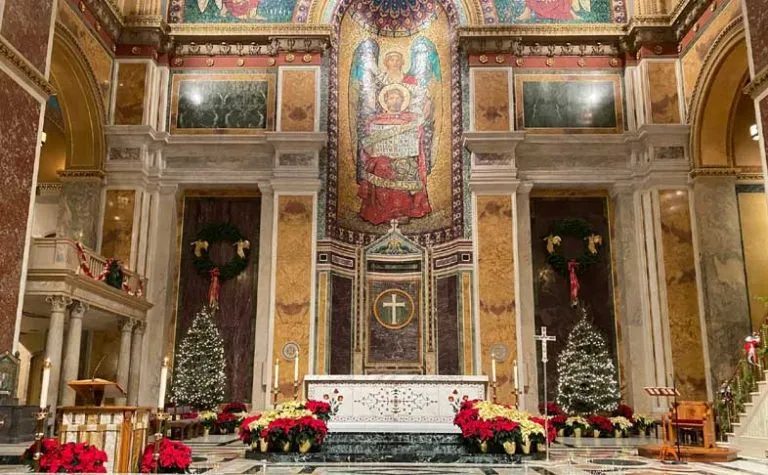
Since the St. Matthew’s Cathedral cornerstone was laid in 1893, time and weather took a heavy toll on its roof, support structure and interior. Culprits included airborne pollution, wind, water, snow and ice. In 1998, our architect and structural experts said the existing dome and roof would be safe only until the year 2000. A campaign ensued to give the Cathedral its first complete restoration, which began in 2000 and was completed by September 21, 2003, the Feast of St. Matthew the Apostle.
Exterior
Dome – One hundred ninety feet from ground level at the top, the dome has been completely renewed. The pitted and eroded copper was removed and and rotted wood was replaced. A protective membrane was applied before the new copper was installed.
Roof – The original slate had outlasted its life expectancy of 70 years by more than 30 years. Many pieces were worn, brittle and cracked. These too, have been replaced with new slate, also with a waterproof membrane underneath.
Façade – Its ability to withstand the elements was compromised by unstable mortar joints, cracked terra cotta, loose brick, and rusted steel window frames. The mortar joints have been repointed.

Interior
Mosaics and Marble – Craftsmen repaired and cleaned the central sanctuary mosaics. In some places, the mosaics had separated from the wall. The marbles and ceilings were restored in the sanctuary, Blessed Sacrament Chapel, Wedding Chapel and Angels’ Chapel. Work then moved to the area above the communion rail and mosaics of the pendentives that depict the four evangelists.
Murals – Cleaning was required for the accumulated incense, candle residue, grime and dirt that dulled and darkened the luster and brilliance of the murals. These bright colors can now be seen for the first time in many years.
Ceiling – The ceiling was restored to correct an unsound support system. Wood framing showed signs of stress and some of the plaster coffers had moved and cracked. Water was responsible for blistering paint and damage to the major arches. Ceiling elements were repaired and, in some cases, replaced.
Fire and Safety – Some electrical circuitry and wiring dated to 1895 and was replaced to avoid the possibility of fire. Some original wiring was minimally insulated, jacketed with cotton and subject to fibre rot and abrasions. Since interior wood and plaster are highly combustible, enhanced fire and safety measures were mandatory.
Plastering and Repainting – Water-damaged plaster and blistering paint were removed in several chapels. These areas were then plastered and painted.
Lighting and Organ – New lighting was installed so that visitors can now clearly see the restored mosaics, murals, ceiling and other features of the interior. The new organ, installed beginning in 1995, will eventually be completed, doubling its number of pipes to its full complement of 5,045.
Crypt
Near the entry of the St. Francis Chapel is a burial crypt with eight tombs intended for Washington’s archbishops. Three former archbishops, Patrick Cardinal O’Boyle, William Cardinal Baum, and James Cardinal Hickey, are interred here.
Organ
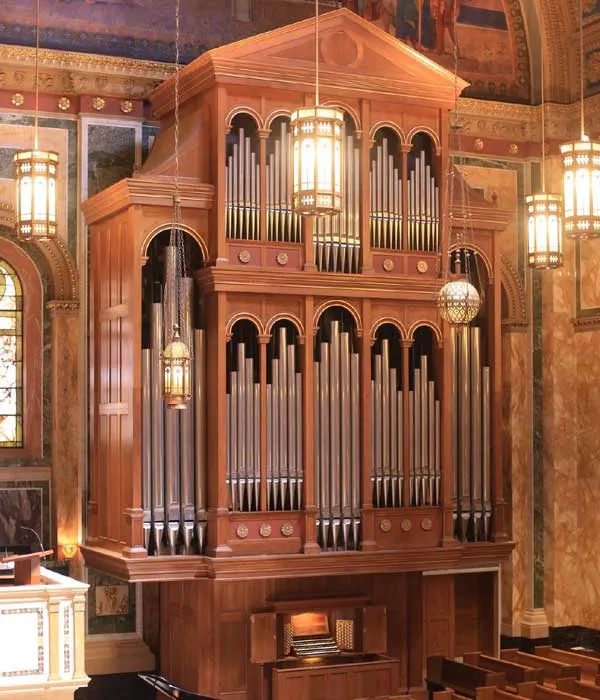
The Cathedral has a magnificent four-manual French Romantic organ built by the firm of Lively-Fulcher. In addition to being played at Mass and other liturgies, the organ is featured each year in concerts and recitals that are always free and open to the public.
We are delighted to announce that, nearly 25 years after the initial partial installation of the Lively-Fulcher Great Organ at the Cathedral of St. Matthew the Apostle in Washington, D.C., the organ is now complete. In June 2018, the original builder returned to the Cathedral to begin work on the long-awaited completion. All five divisions of this four manual mechanical action French Romantic organ were heard for the first time publicly on Friday, May 10, 2019 at a recital that began at 7:30 pm.
Features of the Organ
The organ case is built of white oak and contains polished tin pipes in the facade. It reaches a height of nearly forty-five feet at the peak. The goal was that the case not only functions well, but makes an artistic visual statement in harmony with the Cathedral architecture. The instrument contains five divisions and 68 stops.
The organ takes its inspiration from the 19th-century French organ building traditions but is designed to maintain polyphonic competence for earlier music. The unusually complete stop list allows for the performance of vast and varied organ literature and will serve its liturgical role in a noble fashion.

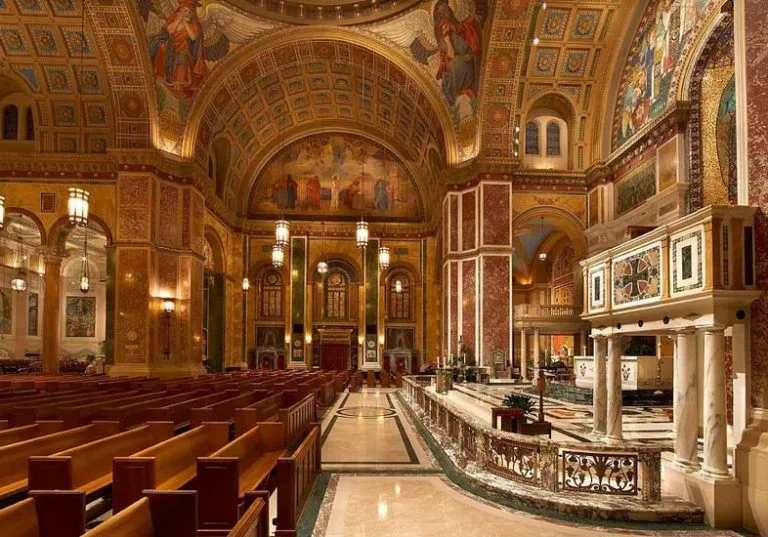
Feast Day – 21st September
The Annual Feast Day of St. Matthew is celebrated on 21st September.
Mass Time
Weekdays
Saturdays
Sundays
Church Visiting Time
Contact Info
1725, Rhode Island Ave NW,
Washington, D.C., 20036, United States
Phone No.
Tel : +1 202-347-3215
Accommodations
How to reach the Cathedral
Ronald Reagan Washington National Airport in Arlington, Virginia, United States is the nearby airport to the Cathedral.
Farragut North, Farragut West & Dupont Circle Metro Station are the Subway Stations in Washington, D.C., United States which are nearby to the cathedral.

